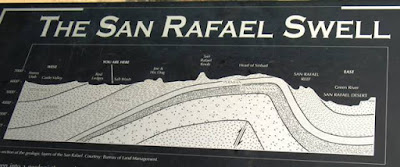
Toiyabe Mountains, Nevada:
Looking south from S.R. 722, formerly known as Route 2, AKA old Highway 50.
This month's
Accretionary Wedge is all about what was the most significant geologic event - in my life, no matter how small or large, no matter when it happened. This Wedge is hosted by Julian at
Harmonic Tremors, who will be posting results after May 21st. As
Geotripper and
The Lost Geologist have both already pointed out, there are numerous geologic events that could qualify as major or significant (ooh, "significant" - one of those wiggle words!), even if one restricts oneself to merely the Mesozoic and Cenozoic eras of geologic time. If one digs deeper? What about the formation of the earth itself? What about the advent of life sometime in the Precambrian or the first fossil preserved in the geologic record? (Our knowledge of that first keeps changing.) What about the cooling of the hot, molten earth after it formed? What about the largest ever mass extinction at the end of the Permian? What about...? Obviously the list could go on and on and on.
I can think of two fairly significant geologic or geological events that have affected my life considerably. The first would be the postulation and then discovery of low-grade, disseminated, "no-seeum" gold in what would come to be known as the Carlin-type deposits. The
history of that event and process is quite interesting, and had I known about the future of the Carlin Trend when I was five, perhaps I could have, in 1958 while passing through the Carlin area, invested all of my hard-earned and diligently saved money from my allowance (about $5.00 total saved at the time?) in buying some ranch land somewhere near Carlin north of the future site of I-80 - then Highway 40! Maybe I could have staked one claim! Well, that's just an old fantasy of mine - if I only had known.
I think that really, the combined geologic events that have most affected my life were the various plate tectonic settings that shaped the western U.S. into its present configuration of accreted and obducted terranes, with the Sierra Nevada batholith
intruding beneath volcanoes in the Mesozoic and then rising to its present height from the Miocene until to today (10 to 0 Ma), the San Andreas and related faults slicing through part of California from the Tertiary onward to today (34 to 0 Ma), and the almost world-wide unique formation of the Basin and Range starting in the middle Tertiary and continuing until today (17 to 0 Ma). The Basin and Range is at its most elevated height in the Nevada region and is widest in Arizona(or Mexico?). The many tectonic events that formed the overall geology of the Basin and Range of Nevada began prior to the onset of Roberts Mountains thrusting in Devonian and Mississippian time, continued with
flat subduction during the Laramide orogeny in late Mesozoic and early Tertiary time, became quite prominent with the onset of strike-slip faulting along the western margin of California in middle Tertiary time, and continue with ongoing Basin-and-Range faulting and earthquakes to
this very day. These many interconnected geologic events have structured my life ever since I moved here to go to graduate school in 1975.
What really got all this going, however, was more of a geological event (the
USGS 1958, 1978, and 1991 Suggestions to Authors make the distinction between using the adjective "geologic" for naturally occurring events or items and "geological" for man-made events or items -- the former would include "geologic history" and "geologic process," and the latter would include a U.S. "geological survey" and a "geological society"). What I'm really saying is that the existence of the geologic process of plate tectonics goes on and has gone on without man's recognition of it. So it is really the geological event of the discovery of and then final acceptance of the whole of plate tectonics that has really had a significant impact on my life.
Where I went to undergrad school on the east coast, my major professor,
Dr. W. G. Lowry, a very good structural geologist, was an "old school" hardliner who had refused to accept plate tectonics as a theory -- and so I didn't hear much about it in my early undergrad years, except for a couple occasional rants against it (certain fossils on South America and Africa supposedly didn't fit the theory, and matching the structural geology of the northeastern U.S. and eastern Canada across the Atlantic with the structural geology of the British Isles supposedly didn't work). Later, when I took stratigraphy while still an undergrad at the same school, I was able to see a little farther into the realm of plate tectonics and active margins in particular, because our stratigrapher-paleontologist,
Dr. C. G. Tillman, did accept plate tectonics as a viable and useful theory. And so, during my last year there, I learned a bit about subduction and Accretionary Wedges (although I'm not sure that last term was in use at the time).
It all came together for me while working at the USGS in Reston, VA, for a short stint prior to going to grad school in the west.
Dewey and
Pitman came and gave a several-day lecture series on plate tectonics, and even the "junior geologists" like myself were allowed to attend. They presented all the ideas and information known at the time, and I kept my notes from their lecture series for many, many years.
Moving to Nevada later that year to go to grad school finally settled me in to a countryside of western-style, well-exposed geology in an obviously still active geologic setting. (See
this post for one comparison of west v. east.)
Accretionary Wedge #9: Significant Geologic Events


















































